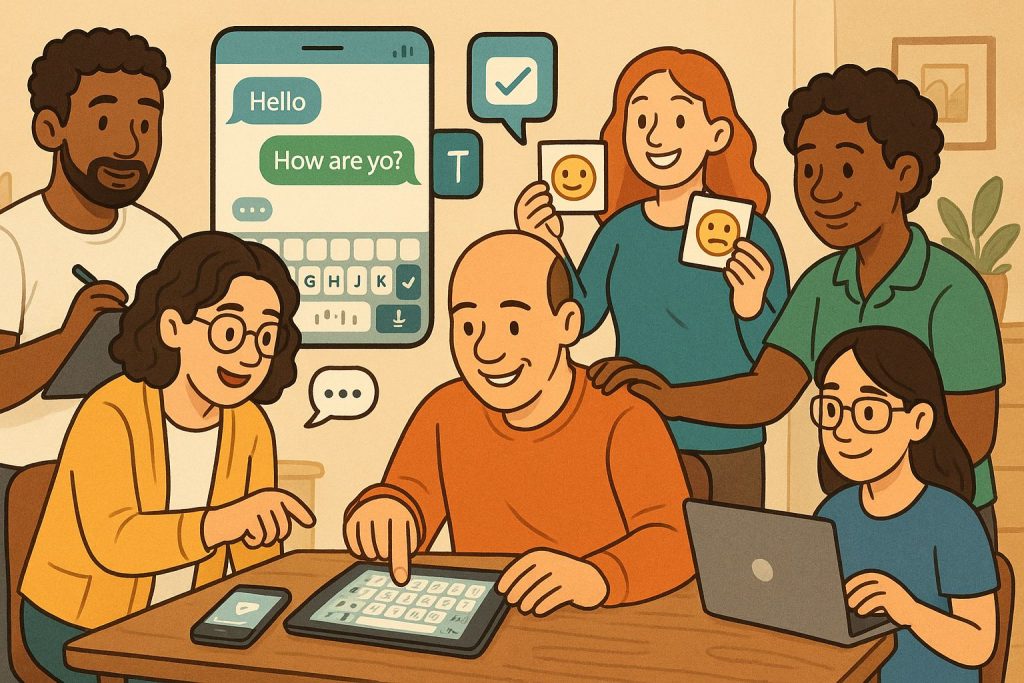
The shift toward digital communication has reshaped how we think about writing—not only for the general population but also for individuals with aphasia (PwA). Traditional writing practices such as handwriting are increasingly supplemented or replaced by texting, typing, and other digital modalities. For interdisciplinary therapists supporting clients with neurological conditions, this shift demands a broader clinical lens.
Digital writing is no longer optional—it is a lifeline for communication, independence, and social participation. Yet, the impact of these tools varies across individuals and must be assessed with nuance and inclusivity.
Why Digital Writing Matters in Aphasia Care
Texting and typing have become dominant forms of everyday communication. People send appointment requests, update caregivers, and maintain friendships through written digital messages. For individuals with aphasia, difficulty with writing—already a major barrier—can be compounded by the challenges of navigating modern platforms and interfaces.
As Dietz et al. (2011) noted, integrating technology into therapy offers new ways to support language recovery and social engagement. Today’s norms also accept spelling shortcuts, emojis, and even incomplete phrases. This more flexible standard can reduce pressure and expand opportunities for communicative success in therapy.
Typing vs. Handwriting: Same Goals, New Mediums
Recent studies suggest that at the group level, PwA show comparable performance in typing and handwriting regarding correct information units and utterances (Obermeyer et al., 2024). However, individual differences are important.
Typing often results in slower output, more deletions, and higher spelling error rates. These effects can vary based on lesion site, motor planning issues, and familiarity with digital interfaces (Lee et al., 2024). This insight is critical for therapists choosing the most effective and functional writing modality for their clients.
Applications for Speech-Language Pathologists
SLPs can integrate texting and typing into language therapy to target functional writing goals. AI tools like predictive text and autocorrect can scaffold word retrieval. DAAWN (Menger et al., 2021) allows therapists to assess typing skills through structured tasks and receive automatic reports on output quality.
Additionally, using the Texting Transactional Success Scale (Lee & Cherney, 2022) lets SLPs evaluate whether clients can successfully complete communication exchanges using messages. This is ideal for social communication goals and generalization into everyday contexts.
Applications for Occupational Therapists
For OTs, keyboarding and touchscreen typing are functional ADLs. Fine motor planning, sensory regulation, and visual-spatial processing are all part of successful digital writing. The Technology Survey (Kinsey et al., 2022) is a helpful tool to determine clients’ device usage, confidence, and motivation.
OTs can incorporate texting tasks into broader technology use goals, such as accessing medical portals or coordinating with caregivers. Interventions might include adapting stylus grips, adjusting typing settings, or exploring voice-to-text as compensatory strategies.
Relevance for Physical Therapists
While digital writing might seem outside a PT’s scope, the motor aspects of typing and digital device use are crucial for clients with upper limb motor impairments or coordination difficulties. PTs can collaborate with OTs and SLPs to improve postural support, arm control, and endurance for sustained writing or typing tasks.
Moreover, communication tools like texting can support PT-led home programs. For example, patients with aphasia may benefit from receiving simplified text instructions, images, or reminders in therapy-friendly formats.
Psychomotor Therapists and Cognitive-Motor Integration
Psychomotor therapists support the integration of body movement with cognitive and emotional processing. Typing and texting tasks offer rich opportunities to address cognitive-motor planning, visual tracking, bilateral coordination, and timing—all within a communication-focused framework.
Integrating free text tasks, emoji use, or sequencing writing prompts into psychomotor sessions can build self-regulation and executive function while reinforcing meaningful communication.
Supporting Special Educators and Assistive Communication
Special educators working with students with acquired brain injury or developmental language disorder also benefit from these tools. Platforms like DAAWN and texting scale assessments allow for personalized, adaptive written expression tasks.
AI tools can be used to co-create stories, label images, or send simulated text messages to characters—turning literacy tasks into interactive, communicative learning experiences. For older students or transition-aged youth, these tools foster digital literacy, independence, and social-emotional expression.
Conclusion: Beyond Traditional Writing
As Thiel and Conroy (2022) argue, writing remains deeply personal and powerful for people with aphasia. It’s not just a skill—it’s a means of reconnecting with the world. By integrating texting and typing into therapy, we make communication more real, more modern, and more relevant.
For therapists across disciplines, this means adapting goals, tools, and expectations to reflect the way people live, learn, and communicate today. Writing is no longer just about paper and pen—it’s about access, agency, and connection.
References
Dietz, A., Ball, A., & Griffith, J. (2011). Reading and writing with aphasia in the 21st century: Technological applications of supported reading comprehension and written expression. Topics in Stroke Rehabilitation, 18(6), 758–769. https://doi.org/10.1310/tsr1806-758
Kinsey, L. E., Lee, J. B., Larkin, E. M., & Cherney, L. R. (2022). Texting behaviors of individuals with chronic aphasia: A descriptive study. American Journal of Speech-Language Pathology, 31(1), 99–112. https://doi.org/10.1044/2021_AJSLP-20-00287
Lee, J. B., & Cherney, L. R. (2022). Transactional success in the texting of individuals with aphasia. American Journal of Speech-Language Pathology, 31(5S), 2348–2365. https://doi.org/10.1044/2022_AJSLP-21-00291
Lee, J. B., Kinsey, L. E., & Cherney, L. R. (2024). Typing versus handwriting: A preliminary investigation of modality effects in the writing output of people with aphasia. American Journal of Speech-Language Pathology, 33(6S), 3422–3430.
Menger, F., Forshaw, M., Morris, J., & Osselton, R. (2021). Digitised Assessment for Aphasia of WritiNg. https://daawn.ncldata.dev
Menger, F., Morris, J., & Salis, C. (2016). Aphasia in an internet age: Wider perspectives on digital inclusion. Aphasiology, 30(2–3), 112–132. https://doi.org/10.1080/02687038.2015.1100702
Obermeyer, J., Edmonds, L., & Morgan, J. (2024). Handwritten and typed discourse in people with aphasia: Reference data for sequential picture description and comparison of performance across modality. American Journal of Speech-Language Pathology, 33(6S), 3170–3185.
Thiel, L., & Conroy, P. (2022). “I think writing is everything”: An exploration of the writing experiences of people with aphasia. International Journal of Language & Communication Disorders, 57(6), 1381–1398.
